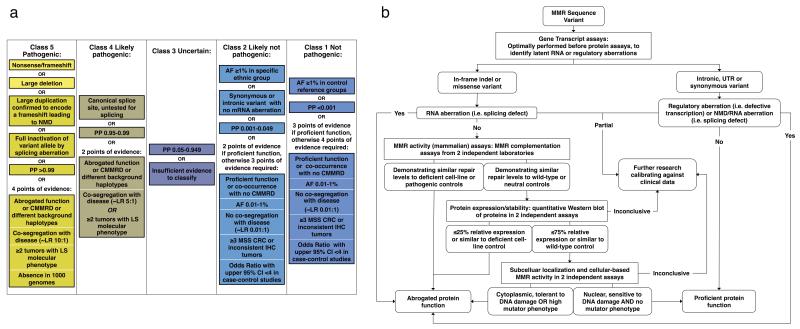Figure 1.
Overview of 5-tiered InSiGHT classification guidelines.
(a) Simplified guidelines describing levels and types of evidence required to reach different classes. See the supplementary information for the full guidelines (Supplementary Note) and detailed rationale behind each criterion (Supplementary Table 3). The Lynch Syndrome molecular phenotype described in Classes 5 and 4 includes microsatellite instability and/or loss of expression of relevant protein(s) as determined by immunohistochemistry. In this study, variants resulting in a premature termination codon or large genomic deletions of functionally important domains, generally considered pathogenic on the basis of DNA sequence alone, are referred to as Class 5a “assumed pathogenic” variants. All other variants reaching class 5 are termed Class 5b. (b) Flowchart used to assist in interpretation of available functional assay data. Assays reviewed for classification are shown in Supplementary Table 4, and the values used to define abrogated or normal function are shown in Supplementary Table 5. The cut-offs <25% and >75% set for protein expression, as used in previous publications47,48, are very conservative given reported abrogated function associated with MLH1 expression defects of ~50% or lower49. For variants that had normal/inconclusive/intermediate MMR activity in 2 independent assays, but deficient protein function in 2 independent assays, abrogated function was assigned. AF – allele frequency; PP – posterior probability of pathogenicity derived by multifactorial likelihood analysis; CMMRD – constitutional mismatch repair deficiency (MIM 276300); LR – likelihood ratio; LS – Lynch Syndrome; MSS – microsatellite stable; CRC – colorectal cancer; IHC – immunohistochemistry; NMD – nonsense mediated decay.

